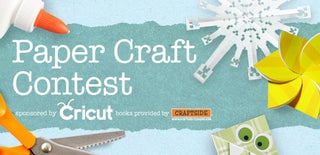Introduction: Making (Six-Sided) Paper Snowflakes LIKE a BOSS
I started making paper snowflakes pretty much from the moment my parents decided young me could be trusted not to maim myself or my siblings with scissors. There was a dearth of papercutting during my teenage years, but I picked it up again in college. Oh boy did I ever pick it up again. :B
Here's how I do what I do.
Time: Varies
Skill: Moderate
Caution: This project calls for the use of very sharp knives.
BE RESPONSIBLE WITH STABBY, CUTTY THINGS, M'KAY?
Step 1: Materials
- Paper
- Craft knife (X-acto, etc.) or very sharp, fine-tipped scissors. Craft knives are better, though.
- Cutting mat. I find flattened cereal boxes are excellent for this. (Don't use corrugated cardboard as a cutting mat. The knives will just punch right through the top layer into the spaces between, making your cuts too large and destroying any fine details there might be in your design.)
- Pencil
- Eraser
- Protractor
- Ruler
- Compass
- Various design templates and stencils
Step 2: Foldin' Foldin' Foldin'
Instead of folding the paper in half over and over, the trick to making six-sided paper snowflakes is to fold it first in half and then at 60°.
Basically you divide 360 by however many sides you want, and that will tell you at which angle to fold the paper to get that number of sides.
360° / 4 = 90°
360° / 6 = 60°
360° / 8 = 45°
360° / 10 = 36°
360° / 12 = 30°
360° / 14 = 25.714285etc. ...Okay, so maybe not that one.
Anything over eight sides starts getting too thick for extreme detail anyway.
The end result will be slightly different depending on whether you fold the paper in half along the long axis or the short. The overall surface area is the same -- the shape is just a bit different -- and you can use this to your advantage to maximize the space available for certain designs.
Step 3: Feeling Kinda Sketchy
Yes, you could just grab your knife or scissors and start hacking away, but to get the truly crazy-detailed sort of snowflakes, it is a big help to plan and draw out the design first. 1mm is about the thinnest I go with my pattern lines. Anything smaller is too flimsy and far too easy to tear accidentally. Make sure every element connects to something else in at least one place, but preferably more. The more connection points between design elements, the sturdier the finished snowflake will be.
Step 4: Going Under the Knife
Grab your sharp things!
And your cutting mat!
Really, you need a cutting mat of some kind. Don't want to damage your table, and especially don't want to prematurely dull your knife.
Keep the blade as perpendicular to the paper as possible. Cutting on an angle, especially around any very thin strips, makes you far more prone to accidentally cutting through something you wanted to keep, and mangling your design. The top layer or two will be intact, but the underlying layers of the snowflake will be cut too close and the lines will break because they're too thin, or will be cut clean through altogether.
If a waste piece is refusing to detach from the rest of it, DO NOT TUG ON IT to get it off. This is an invitation to disaster. Simply pulling on it until it comes loose more often than not will also rip something that you want intact. Instead, turn the snowflake over and see if you can spot where it's still connected, cut those, then remove the piece.
The time it takes to cut out a flake like this varies a lot depending on the amount of detail. My simple ones I can knock out in a half hour. My most complex to date took over four hours. If yours is shaping up to be a job of an hour or more, take breaks, change up your grip, switch hands now and then if you have the ability like I do. Early on in my career of insane snowflakes I gave myself a blister from the knife because I went almost a full three hours without pausing. Don't do that. Learn from Chim.
If/when you pause in the cutting, cap/retract/remove the blade from your knife and store it somewhere secure. Yes, there are the obvious safety reasons, but it protects the blade from the environment as much as it protects the environment from the blade. You want this thing to be as sharp as possible. Last time I switched out from a dulled blade to a fresh one, wow, what a difference. Preserve that edge.
My favourite knife/blade combo is one of Lee Valley Tools' Veritas carver's knives with the #15 classic scalpel blade. Everyone will, of course, develop their own personal preferences.
Step 5: Open Up!
Time to see how it all looks. This is always an adventure, especially if there was no plan and the sketch was make-it-up-as-you-go, because you never really know how it's going to look in the end until it's properly flattened out.
I run mine through a laminator once they're finished, then keep them all in plastic sleeves in some binders, but they can just as easily be mounted on cardstock or stuck between plates of glass or plastic. Whatever you want, really.
Step 6: Snowflakes Chim Has Made Over the Years
The full collection can be seen over here.

Participated in the
Papercraft Contest













